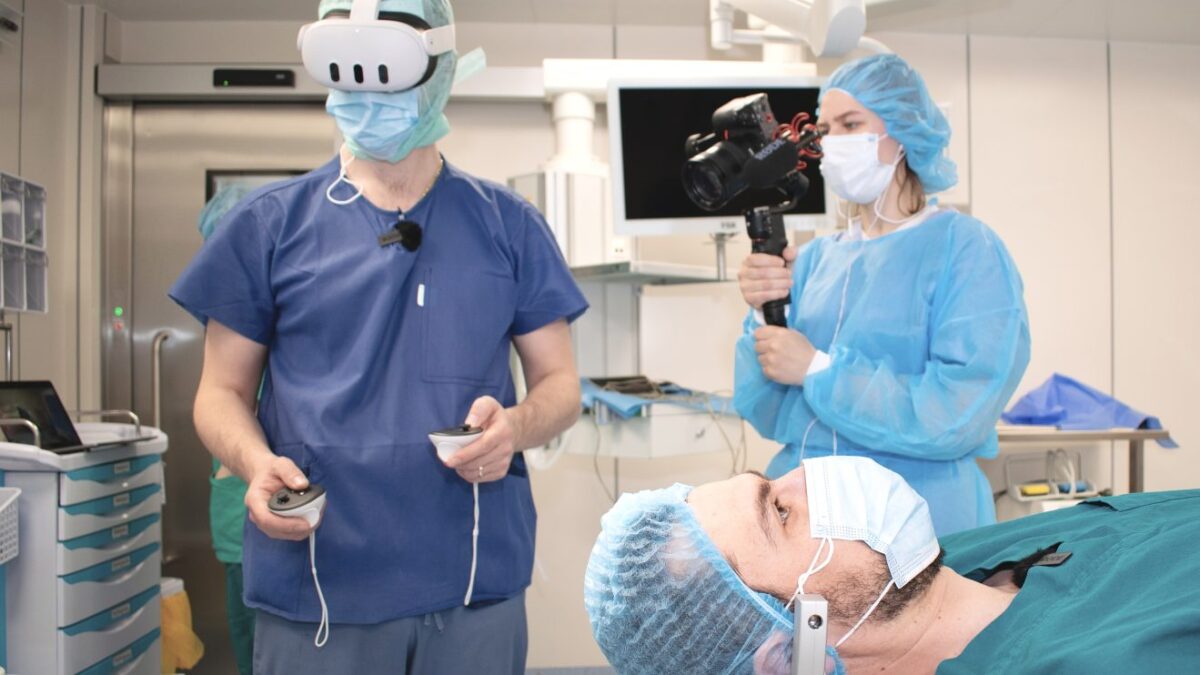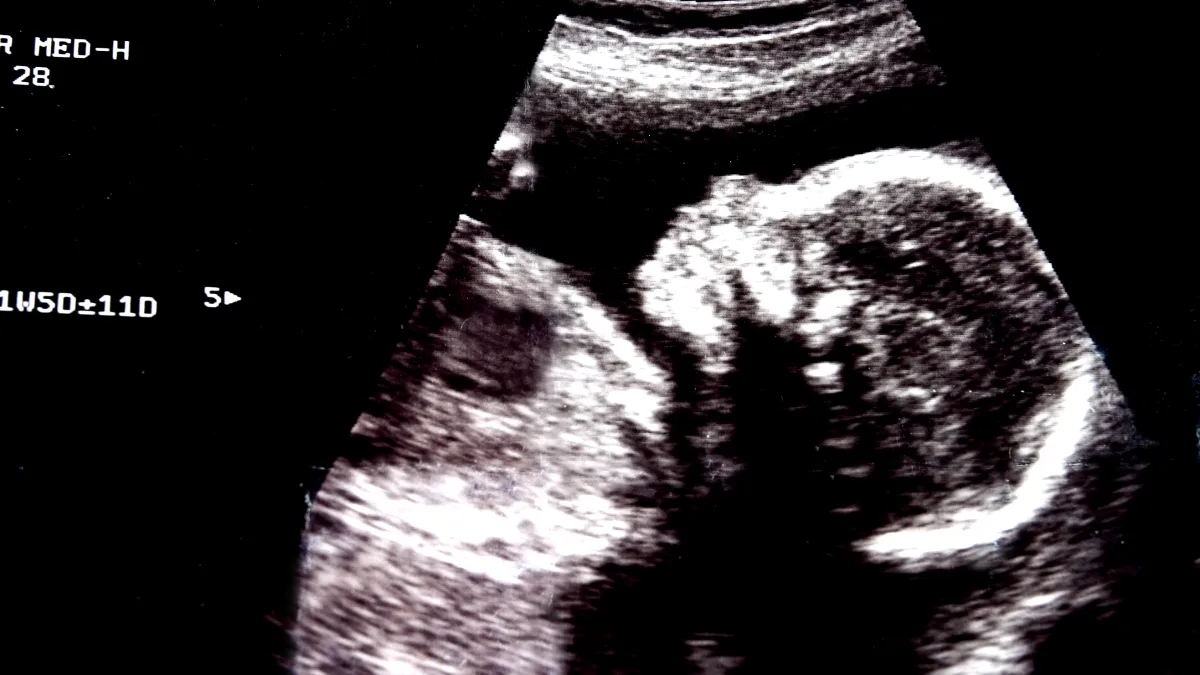Walking through the maze-like corridors of Chișinău’s central hospital, a guide suddenly opens a door to reveal the future.
Inside is a bright operating room. Neurosurgeon Alexandru Andrusca lowers a VR headset over his eyes, a patient’s brain floating in front of him, transparent, and mapped in exquisite detail. A tumour hovers between delicate blood vessels. Far from the usual centres of medical innovation, a Moldovan team was quietly rehearsing brain surgery.
Andrusca is testing a product he created together with AI specialist Vladimir Verbulski and the rest of the team. Their company, Argus AI, allows surgeons to explore patient anatomy in virtual reality. Typically, neurosurgeries use neuronavigation, a costly device, up to 500,000 euros. Argus AI licenses start at 50,000 euros and could be an option for medical centres that don’t have big budgets.

In one of their earliest clinical cases, the Argus AI team used a 3D brain model in VR to help plan the removal of a tumour in a woman’s frontal lobe, identifying angles of approach and key vessels to avoid.
For a prototype, it was a rare opportunity: real feedback from a real case. Now, after two real-life applications during surgery, the product is getting closer to European certification for medical devices, which ensures a product meets EU health, safety, and performance standards.
All procedures so far have been conducted with full ethical approval and patient consent. “We’re testing the hypothesis that with the headset, surgery can be done faster and more safely,” says Vladimir Verbulski. The headset is mainly used during the planning phase, though it can assist throughout the operation itself. The team is also discussing similar clinical trials with hospitals in Germany, Turkey, and the UAE.
Argus AI’s progress hasn’t gone unnoticed. With just 25,000 euros in funding, the team won the Techstars Startup Weekend AI Edition, Startup Grind Pitch Battle, and the LevelUP Startup Accelerator. They also secured a full scholarship to Draper University’s 2025 summer edition in Silicon Valley.
A virtual step ahead
Using scans from MRI and CT machines, the team constructs immersive virtual reality environments that allow surgeons to explore and rehearse complex procedures, before they even set foot in the operating room. “One wrong move can destroy [brain] tissue that doesn’t regenerate,” says Alexandru Andrusca, who adds that the VR solution makes the operation more accurate.
Alexandru, who taught himself programming before medical school, says the real value of Argus AI lies in its bridging of two worlds: clinical knowledge and technical precision. “There are doctors, and there are programmers. But almost no one in between,” he explains. “I realised I could be that bridge.”

Argus AI hints at what is ahead for Moldova’s health tech sector. Its early success stems from Moldova’s rare combination of regulatory flexibility, medical accessibility, and close-knit collaboration between surgeons and engineers.
In most other European countries, bringing medical innovation to the market can be a lengthy process involving a lot of paperwork. As Mihai Dascăl of We4Health explains, Moldova allows “well-documented trials”, formal trials in clinical settings that help early-stage ideas like Argus AI move beyond the lab.
Moldova as a launchpad for medical technology
Argus AI’s progress is amplified by Moldova’s collaborative networks. We4Health is a Moldovan initiative, launched at the beginning of 2025, to connect healthcare thought leaders, innovators and experts to accelerate health innovation. It brings together professionals from the private sector, academia, and government to close the gap between clinical practice and innovation.
Spearheaded by Mihai Dascăl, a professor and innovator, the initiative addresses gaps between private, academic, and public health sectors. Dascăl also leads Baby Medy, a start-up streamlining paediatric care through digital tools, reflecting his broader vision to position Moldova as a regional health tech nexus.
According to Dascăl, Moldova’s start-up ecosystem is uniquely positioned to bridge research, regulation, and practice. “We want to become a regional health tech centre.” To achieve this, Moldova needs investors. Even if cheaper than in the rest of Europe, clinical trials are still costly.
Moldova Innovation Technology Park (MITP) has become a key platform for healthcare startups. Offering a single seven per cent tax rate and simplified admin procedures, MITP helps early-stage health tech teams scale faster, form partnerships, and access a network of companies. Through initiatives like Tech Clusters and international partnerships, MITP connects Moldovan innovators with global markets.

Building the digital infrastructure
Moldova’s new digital strategy also covers the health-care sector and The Ministry of Health is embracing digital tools. State Secretary Alexandru Gasnaș explained that Moldova’s current health information ecosystem is still fragmented. Out of hundreds of applications and databases, 48 core systems have been identified for integration.
“We have a lot of disconnected systems, most of them focused on hospitals and not on primary care,” says Gasnaș. The government is now working on creating a unified framework to connect them, with telemedicine at the center of this reform.
In partnership with the World Health Organisation (WHO) and Centres for Disease Control and Prevention, the national public health agency of the United States, the country is advancing health data governance, interoperability, and literacy. Moldova’s 2023–30 Digital Transformation Strategy aligns the country with EU standards.
“Leveraging the value of health data and technology offers unparalleled opportunities for Moldova,” Dr Charles Vitek of the CDC told the WHO news platform.
What makes Moldova different
Beyond innovation, Moldova is also seeing economic impact when innovating the medical sector. Medical tourism brought 50 million euros to the country in 2022, and growth is accelerating. The Smile Dent Team, Moldova’s largest dental clinic network, receives over 300 foreign patients each month, many from Italy, France, and the US.
“We offer airport pickups, hotel stays, and world-class dental services,” says founder Vadim Vetrilă. His clinic’s lab, the largest in Europe, designs 3D-printed implants, crowns, and full dental restorations. “It’s about quality and affordability,” he adds. A full dental reconstruction that costs 40,000 euros in Italy can be carried out in Moldova for 10,000 euros.
Moldova’s fertility doctors, cosmetic surgeons, and wellness clinics are also attracting international clients. With visa-free travel and competitive prices, the country has become a new destination for affordable care.
There are still gaps to fill, but Moldova has a rare mix of ingredients: motivated founders, educated medical professionals, open government, and increasing international collaboration. As Mihai Dascăl puts it, “In tech, you can just build. In medicine, you need validation and clinical logic.”
Moldova, it seems, could offer both.
Photos by Iurie Gandrabura.







